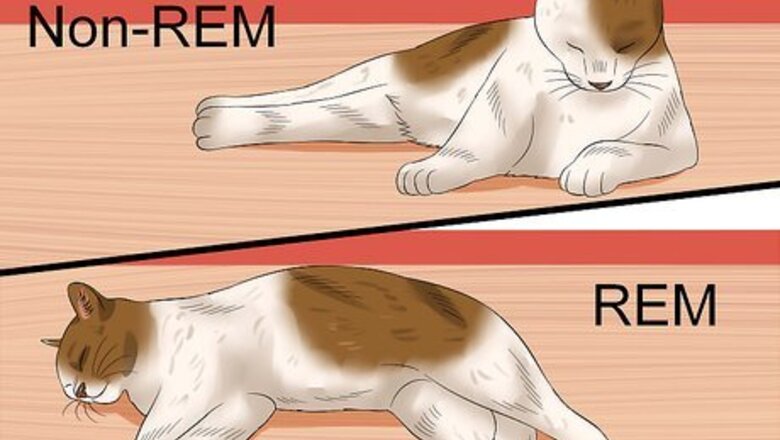
views
Waking a Cat
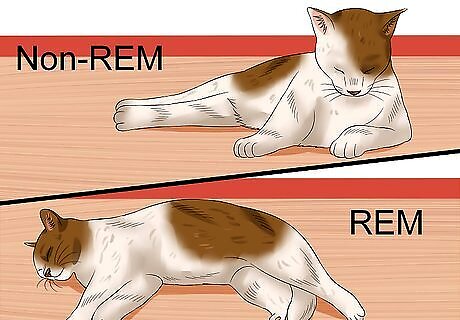
Recognize the sleep stage. Normally, it's fine to wake a sleeping cat. However, there are two stages of sleep that are important to a cat's well-being: Rapid Eye Movement (REM) sleep and Non-REM (NREM) sleep, also called deep sleep. If a cat is deprived of these sleep stages, he may become irritable or lethargic. If you think your cat is in REM sleep or deep sleep, you may want to let him be. REM sleep usually comes before deep sleep. A cat may move slightly, and his eyes may twitch. His face or body may move or twitch slightly. During deep sleep, your cat will be largely motionless and appear relaxed. Your cat will be very still and spread out in a comfortable position. He may be lying down or curled up, and may not respond quickly to noise or commotion. Cats do need more sleep than most mammals. REM and deep sleep are important to restore a cat's immune system and generally repair and regenerate his body. It's a good idea to let your cat be during these sleep stages unless you feel moving him is absolutely necessary.
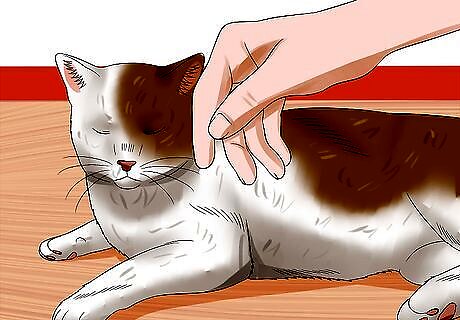
Try a light touch. While cats sleep frequently, they are not always in REM or deep sleep. Usually, cats take light naps throughout the day. During these light naps, cats are still in tune to their environments. This is a survival mechanisms inherited from ancestors to help wild cats stay safe from predators and threats when sleeping during the day. A small touch will easily wake a sleeping cat most of the time. You can try lightly brushing your cat's head or the tip of his ear. Try to keep your touch gentle. Remember, cats sleep lightly as a way to ward off predators. You want to make sure your cat does not see you as a potential threat. If you need to move your cat, try to get him to move right after he stirs. Cats usually fall back to sleep quickly once they see there's no real threat. As soon as you get your cat awake, coax him off the couch or pick him up and move him.

Make a small noise. If your cat tends to be on the skittish side, he may bite or scratch if touched in his sleep. Instead, you can try making a small noise. You can whistle, hum, or call his name to get his attention. As with touch, you want to gently coax your cat out of his slumbers rather than startling him. Try a soft, soothing noise. You should avoid yelling at your cat to wake him up. Cats do not take well to yelling. If you yell at your cat frequently, he may become fearful and begin avoiding you.
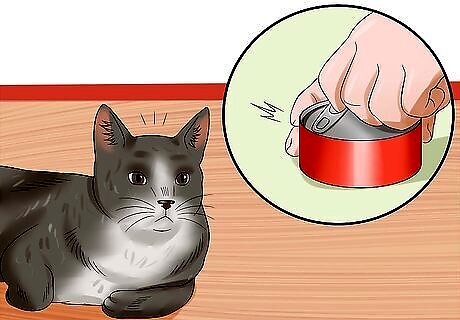
Use food. If your cat is very skittish, waking him up with sound or touch may frighten him regardless of how gentle you are. You can try to coax him awake with food. Shake his bag of cat food or open a can. You can also rattle a treat bag, or place some of his favorite table scraps near where he's sleeping. He may get up to go for the food, getting him out of the way.
Avoiding Pitfalls

Allow your cat to get enough sleep. Cats need a lot of sleep, so you should not be constantly waking your cat up. Cats, on average, sleep for about 15 hours a day. House cats still retain a wild streak, and their bodies are primed to sleep on and off during much of the day as they would in the wild. Do not wake your cat up unless it's absolutely necessary. For example, you may need to wake your cat up to take him to the vets. Accept that your cat's sleep schedule may not match yours. Cats are often most active around dusk, and may sleep a lot during the day. Cats are highly domestic. If your cat is attached to you, he may gradually adjust his sleep schedule around yours. However, cats generally do not take to a regular sleep/wake cycle like humans do.

Recognize signs of a seizure. During REM sleep, cats may twitch and move around in their sleep. This is a normal part of the REM cycle. However, cats may also sometimes have seizures during sleep, which can last up to 5 minutes. A vast majority of health conditions, ranging from heat stroke to neurological issues, can cause seizures. If your cat has a seizure, he should be medically evaluated. Make sure you know how to recognize the difference between a seizure and REM sleep. During REM sleep, a cat will wake up if you touch him or shake him gently. Any twitching movements will stop as soon as the cat opens his eyes. You cannot wake a cat up during a seizure and the movements will continue for the duration of the episode, which can be as long as 5 minutes. Seizure movements may be more severe than REM movements. You may also notice your cat foaming at the mouth or drooling.

Do not let young children wake up a sleeping cat. If you have young children, they may frequently want your cat's attention. They may want to know how to wake up a sleeping cat. However, you should not allow young children to wake up your cat, as they may overdo it. Cats need solitude, quiet time, and quality sleep to be healthy and happy. As a rule, do not allow children to wake up a sleeping cat.
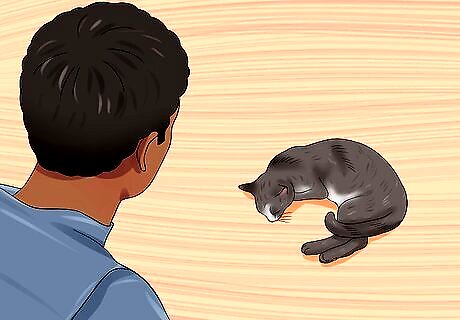
Monitor your cat's sleeping habits. As with any other aspect of your cat's behavior, keep an eye on his sleeping habits. As cats sleep so much, it's unrealistic to time how many hours a day your cat sleeps. However, get a sense of when your cat is generally asleep and when he's generally awake. If your cat suddenly starts sleeping more often, talk to a vet. Changes in sleep habits may indicate problems like depression, boredom, or illness.
Encouraging Quality Sleep
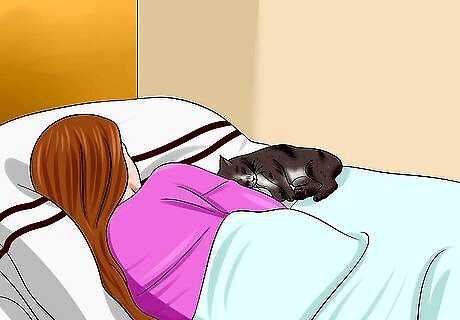
Decide carefully if you want to allow your cat to sleep in the bed. Many cat owners allow their cats to sleep in the bed with them. This can be a great way to foster feelings of closeness with your cat and can increase the bond between you and your pet. However, some cats can be difficult sleepers and may keep you up at night. You may frequently have to wake up and move a cat during the night. Consider the sleep quality for both you and your cat. Both you and your pet need high-quality sleep. If your cat keeps you up at night by making noise or hogging space, you're sacrificing your own sleep. If your cat seems uninterested in getting in your bed at night, sleeping near you may cause him stress. Some cats enjoy sleeping in the bed, and may make a lot of noise crying at the door if left out of the bedroom. You can find ways to encourage cats to fall asleep before you, like feeding or playing with them just before bed.
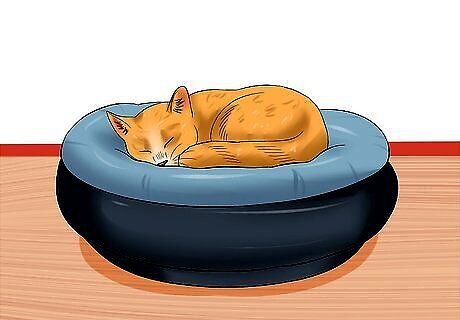
Make sure your cat has many places to sleep. You want to make sure your cat can sleep when he needs to sleep. If you're frequently waking your cat up to move him off of chairs, tables, and other spaces, he may not have space of his own. Try investing in a few high-quality cat beds. Leave them in areas of your home where your cat frequently sleeps or hangs out. You can try putting items that your cat likes, like certain toys, in these beds. You can also clear out space for your cat. If he keeps getting onto the bookshelf, consider letting him have a corner of the shelf to himself. Clear out a pocket of space for him, and lay down a blanket for his comfort.
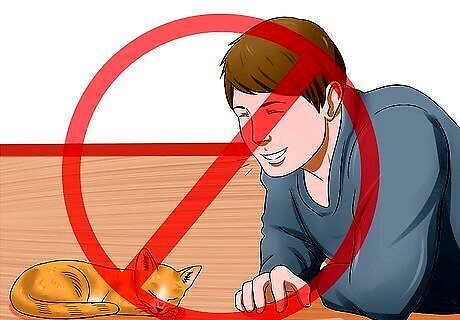
Avoid waking very young cats. Newborn kittens and younger kittens sleep a lot. It takes quite a bit of time for a cat to grow into an adult sleeping pattern. Sleep is important for kittens, as it allows them to build their muscles and bones. If you have a kitten, avoid waking him unless it's absolutely necessary. You want to make sure your kitten gets quality sleep so he can grow up healthy and strong.




















Comments
0 comment